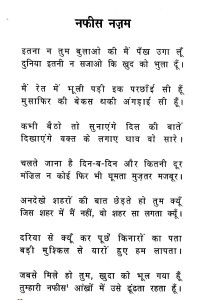THE CREATIVE MIND
I am the creative mind, the Creator’s gift
Do I ever know who I am going to chose
And what I am going to make him write, propound, discover, or invent
Does it unfold on its own
Is it a gift from the heavens?
Or do I dig it from the womb of the earth
Sometimes it falls like the rain
Soaking me through and through
At times it is a boat, taking me on a sail to phantom lands
Some ways are those of a tempest, ripping everything off
Yet maintaining a calm in the eye of the storm
Many times in history it was a cloudburst and all the accumulated burden fell at once upon the paper
I have been doing it in the past
I am at it in the present
I will be in the future
I don’t know whether what I think and ink shall power revolutions or bring peace, or advance scientific discovery
I don’t care whether they will hate me or love me for it
Who writes for awards?
You do it because you have to do it, like you are born with a pen in the mouth
Ha, I miss the silver spoon though
In the gospel it is written, “In the beginning was the Word, and the Word was with God, and the Word was God” !
This is the Alpha and the Omega
The creative mind is the mind blessed by God
Power does not flow from the barrel of a gun
It flows from the subtlety of the Word
I became Hobbes, when I told you about the “war of every man against every man”, and asked you to naturally seek peace
I lived in Locke, and wrote the theory of the mind, defined tabula rasa, gave you the concepts of identity and self
I was in the head of Rousseau, when I wrote “Men are born free, yet everywhere are in chains “, gave you the Social Contract, say democracy
I was with Voltaire when I defended freedom of religious and political thought, and handed to you the power of Reason
I was with Newton when I revealed the Laws of Motion
I permeated Pasteur, and advanced the medical sciences
Galileo saw through me the understanding of the World
I became Einstein and defined the theory of relativity
I made Curie discover radiation, Otto Hahn discover nuclear fission
I’ve led you like Aristotle, Faraday and Fleming of the penicillin
I’ve been with you always
Michelangelo celebrated me as he chiseled the Pietà and painted the Sistine Chapel
Mona Lisa smiles because I gave the mystique look to her eyes through Leonardo da Vinci
Van Gogh brought The Starry Night to life and the Sunflowers to bloom as he was captivated by me
Rembrandt created The Night Watch, as I conceptualized
Shakuntala and Hansa Damyanti became immortalized as I held the brush of Raja Ravi Verma
I have given my best to more like Picasso, Monet, Amrita Sher-gil and Husain
Many more have excelled because they nourished me
When I became joyous, I gave Mozart, the ‘Night Music’ symphonies
I rejoiced as a child when Schumann wrote Caranaval music, ‘Scenes from Childhood’
Chopin, made me his angel and got the Sonatas
Haydn, looked up to me and found his ‘Surprise’ and ‘God of Life’
Even when Beethoven became deaf, I blessed him with ‘Allegretto’
It was not the choice of Columbus to discover America
Nor of Vasco da Gama to discover India
Alexander did not come of his own to meet his greatness
Neither did Ashoka renounce war of his own volition
I, the creative mind, was all the time living in their minds
I was with Martin Luther King Jr. and gave him the speech of the Dream
I powered Gandhi’s resolve to make India independent of the colonial yoke
I have triumphed in the writings of the Sufi saints
I was within Bulleh Shah, when he coined “Bulleya ki jaana main kaun” (Bulleya, to me, I am not known)
I lived with Rumi, as he said, “I am like heaven, like the moon, like a candle by your glow; I am all reason, all love, all soul, by your soul”
I celebrated Kahlil Gibran
I powered Montaigne’s works’
I rejoiced in William Shakespeare, Tennyson, Yeats, Byron, Bacon, Wordsworth, Milton, Keats, Browning and Chaucer
Where all I’ve been all through the evolution of the world, the thought, the philosophy and the Word
Where all I will be is my choice and not yours
I will fill the ones who deserve me
Yet, a little bit of me will be given to each one of you
It will be your purity of emotion, passion, and soul to attain me fully
I AM…
(Copyright: Sandeep Silas)
















































![BEAUTIFUL THOUGHTS by [Silas, Sandeep]](https://images-eu.ssl-images-amazon.com/images/I/51T%2BzYeK4uL.jpg)